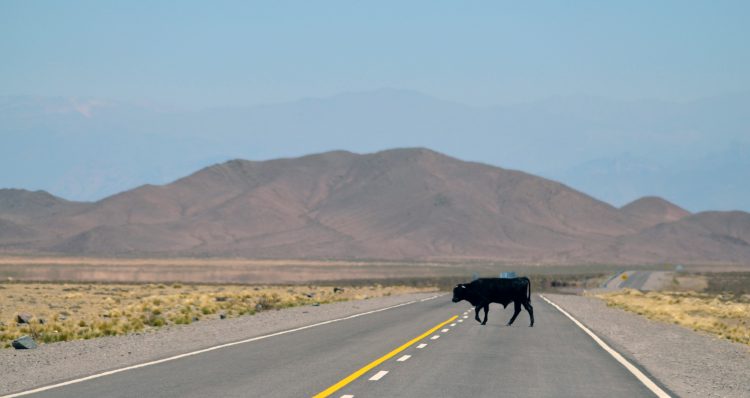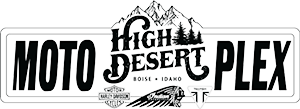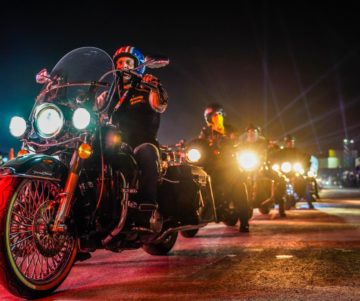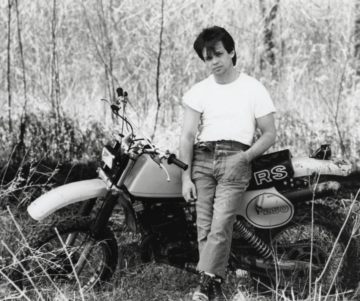
Safe Riding Near Wildlife
Jade Jesser | March 4, 2020 | 0 | Riding , safetyWhen I began coming up with a title for this article, I didn’t know how to put something that would be as eye catching as “How to Enjoy Riding Your Motorcycle Without Dying,” but I kept coming up short. Truth be told, it really is eye-opening to realize how many fatalities involve collisions with animals when it comes to motorcycles. Some studies say that as many as 84% of all accidents involving animal collisions end up in serious injury and often times, death. Hopefully that got your attention, and we can get through some tips on how to not end up in one of the people in this macabre statistic.
Back To The Basics
So before we get into the specifics of riding in areas where there’s a lot of wildlife, we need to have a quick review of the safety practices every rider should know. It really doesn’t matter if you are a 20 year motorcycle riding veteran, or you just got your endorsement yesterday, there are some things you should know. Also, I am not even going to take the time to put anything about riding impaired on here. Don’t be that dumb, ever.
- Braking Skill. There are a couple of things to consider when it comes to braking skill, and motorcycles. The first is equipment: a machine with anti-lock brakes is much more safe than one without. The second is practice: you should use a mile marker or a mailbox to practice braking at different speeds. This is good for you no matter how long you’ve been riding, especially if you are taking the bike out for the first time of a season. Always aim to sharpen your skill in braking.
- Wearing a helmet. This isn’t really meant to be a lecture, or a philosophical discussion. Personally, I believe that riders should be able to choose if they wear one or not, but the numbers seem to support that rider survival is increased by wearing one. Protective gear fits in this category as well.
- Create a safety “bubble.” Space is your friend on a bike, and can give you the time you need to react. Ride towards the center, and make sure you ride staggered when riding in a group.
- Get a good night’s sleep. I’m pretty sure this is self explanatory. If anything, pretend it’s your beauty sleep and that it will help you look cooler on your ride. Whatever you need to do, try to get a good night’s rest before a ride.
- Stay upright. Panicking is the number one enemy of a rider, and many long time riders have become long time riders because they can stay calm under pressure. This is easier said than done, but it might just be the difference between you and a very expensive ride in an emergency vehicle.
- Get good insurance. Not much can help a rider’s safety more than “peace of mind.” Make sure you have everything covered in a worse case scenario.
Critter Considerations
Now that we’ve done a quick review, and all of you have finished doing some braking drills (you did them, right?,) we can move on to thinking about one of the main reasons many of us like to ride: getting into the wild. Speaking for myself, a native Idahoan, this is it: the wilderness, the freedom, the sky, the mountain roads. This is why I like to escape the hustle and bustle of everyday life. Yet with all that wilderness, comes the critters that live there, and there are a few things that we riders can do to maintain a safe ride when we are in their territory.
- The time we ride is important. Dusk and dawn is when most herd animals come out, because this is the time when predators’ eyes have to adjust. Well guess who else’s eyes have to adjust? Riders. So make sure you have a good headlight(s) and proper eyewear.
- Animal eyes are reflective. If you see a pair of small reflective lights up ahead of you… SLOW DOWN!
- Following a blocker, like another car, is a good way to stay safe in areas that are known for wildlife. Get a safe distance behind one of these ‘cagies’ and it can help to clear the way.
- Look for roadkill. Where there’s been one accident, there’s a chance that there will be another. So if you are seeing the unfortunate remains of misfortune on the side of the road, it’s time to slow down.
- Understanding the terrain. This can be easy or difficult depending on your familiarity of an area, but there are a few universals. For example, animals are attracted to water. So if you know you are near a stream or lake, be a bit more vigilant. During hot muggy days, shaded areas are inviting to animals, so be careful when you get into an area like this. If you are traveling in unfamiliar territory, make sure that you read some articles about rides in the area, they will often tell you some of the quirks of a specific area.
- Herds are…well…herds for a reason. In other words, if you see one cow, there are probably more cows. Deer and elk will travel in groups too, so use some common sense here. Look for groups rather than individuals.
Before I get into this animal list, I wanted to share with you what seems to be the consensus about animal whistles that mount on your motorcycle. The basic bottom line is that most veteran riders do not believe that animal whistles are a crucial component in factoring in the safety of your ride. For one, humans can’t tell if they’re working or clogged, because they function like dog whistles and work at a higher frequency than people can hear. Secondly, they may actually startle or even challenge the animal into a collision. So ultimately, whistles aren’t getting on the list as something you should rely on. On to how to deal with specific critters.
How to Handle ‘Em (Smallest to Biggest)
There are a bunch of different animals to avoid when you are riding a bike, and while there is a lot of information out there, and you should always ask a motorcycle instructor or safety official about the specifics in the area you will be traveling, below are some basics that you can apply to most situations.
- Bees – You’d be surprised at just how many motorcycles are caused by bees. There’s really only one way to get past this, and that’s to remain cool and stay upright. No, this will not be easy, especially if you know that you have an allergy, but you have to remember that calmly getting to a safe location to remove your gear is very important.
- Squirrels, Rabbits, and other rodents fall under the category of “if it’s smaller than a soccer ball, just ride through it.” Yet the reason why they are even on here is because people still get hurt, or even die, because of them. You have to stay upright and calm. Don’t get startled and overreact.
- Cats, Small Dogs, Beavers, Badgers, Rock Chucks, Porcupines, and Skunks also should be driven through. Unfortunately as it is, these little fellas just might have the bad day of getting in your way, but swerving is never a good idea. You never know if they are going to zig into your swerving tire with a much smaller contact area. Remember, skunks can spray from a distance so give them space. Skunk spray can actually be so strong it makes riding impossible. Also, porcupine quills can penetrate motorcycle tires, so make sure you are coming to a stop right way in case something happens.
- Birds are incredibly distracting when they hit you. Just remember, even larger birds are fragile creatures in all actuality. So in the event of a collision, the worst that may happen is you get the wind knocked out of you. Hopefully you are wearing protective eyewear or a helmet, but the bird is going to get the bad end of the deal every time. Unfortunately, like bees, the hard part is staying focused and not panicking.
- Dogs – Man’s best friend isn’t always a man on a motorcycle’s best friend. They will chase you, they can catch you, and they might just bite you. Never kick a dog while you are riding. The action of an attempted kick will take your eye off the road, be counterproductive to balance, and give the dog something to play mobile tug a war with. Once a dog begins to chase you, it is important to alter your speed after the dog has committed to a route to catch you. Dogs are distance runners, so once you make a dog slow down, they have a hard time getting moving again. So slow down, and when the dog changes it’s path, speed up and leave them in the dust. Don’t trust that a dog is “playing chase with you.” Dogs are instinctual hunters, and you don’t want to be on the wrong end of the instinct stick.
- Deer are a common animal that Motorcyclists encounter. During my research, I actually watched videos that, even in slow motion, made it seem like a deer just materialized out of thin air. Deer are a huge issue in motorcycle accidents, so they are getting the most focus.
- Talk to hunters. Hunters know where the deer are at whether it’s hunting season or not. SO get the scoop when you are riding in unfamiliar territory.
- Signs are actually there for a reason, and that reason usually has to do with a frequented route of the herd of animals. Pay attention to the signs, and slow down.
- Deer like to hide, and are reactive to proximity. This means that they may stay out of view until you are about to hit them. You can’t always avoid this, but riding close to the center of the road is a good start.
- Deer hang out in groups almost always. If you see one, there are more.
- A deer’s first leap is always the direction they are facing.
- Deer follow headlights. So do not swerve past them, slow down and stop. If you swerve, they might just swerve with you.
- Evasion for deer is a zig-zag pattern. This makes it harder for predators to get a hold of them, and coincidentally, harder for you to get by them. Use your horn to spook them if they are running ahead of you. They may not be scared of your motor, but they might be frightened by a blast of your horn.
- Wolves actually behave a lot like dogs do above, except they are most definitely NOT playing chase with you. Remember, wolves might resemble some breeds of domestic dogs, but if a pack is near people, that pack is hungry. Do not run out of gas, do not slow down. Rarely will you see only one.
- Bears might appear goofy looking, or thanks to your favorite cartoon, cuddly. Just understand that this animal is not around humans because it wants to be, assume it’s hungry and that you are on the menu. This may not be the case, but trust me, you don’t want to be wrong about that. Ever. Don’t get close. Keep your distance. Turn around if you have to.
- Moose, Elf, Cows, and Bison are big herbivores that are the main reason that you are supposed to be practicing hard braking on your motorcycle. There are the basics of physics here, that make everything in this article up to this point very important.
Hitting one of these animals will be like hitting a fleshy wall of concrete.So that means that if you are going too fast, you are going to be the one going ‘splat.’ I can’t stress this enough. No one wins in this scenario.
Another thing about these big animals is that they are not afraid of you in the slightest. Especially during mating season or when they are “in the rut.” Horns might antagonise them, or incite a charge. It is very important not to antagonize the more wild animals on the list, and you might want to think twice about making spooking a cow. They are big enough to cause some serious damage.
Well, that’s about that. There’s a lot of information there to digest I know, but the best piece of advice is simply; “Be careful out there!”
Remember to stay alert and keep scanning the area in front of, and around you. If you want to take in the sights, don’t drift off lost in the beauty of your surroundings. Pull over, and take it in as well as snapping a few photos if need be. Stay safe, and remember, never ever ride impaired.



